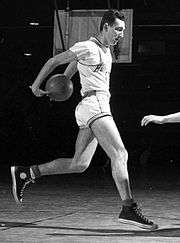Chuck Taylor (salesman)
| Chuck Taylor | |
|---|---|
|
Taylor in 1921 | |
| Born |
Charles Hollis Taylor Abatar June 24, 1901 Azalia, Indiana |
| Died |
June 23, 1969 (aged 67) Port Charlotte, Florida |
| Occupation |
Salesman, basketball player |
| Known for | Chuck Taylor All-Stars |
Charles Hollis "Chuck" Taylor (June 24, 1901 – June 23, 1969) was an American basketball player and shoe salesman/evangelist. He is best known for his association with the Chuck Taylor All-Stars sneaker, the most successful selling basketball shoe in history.
Converse
The Converse All-Star was introduced in 1917, one of the first specifically designed to be worn when playing basketball. Taylor started wearing them in 1917 as a high school basketball player at Columbus High School in Columbus, Indiana.[1] (A.G. Spalding had already been making a basketball-model shoe for nearly two decades.[2]) In 1921 Taylor went to the sales offices of Converse Shoes in Chicago searching for a job. S.R. "Bob" Pletz, an avid sportsman, then hired him.[3]
Within a year, Taylor's suggestions of changing the design of the shoe to provide enhanced flexibility and support, and also including patch to protect the ankle, were adopted. The All-Star star logo was then immediately included on the patch. By 1932 Chuck Taylor's name was added to the patch, and the shoe became the Chuck Taylor All-Stars.
Chuck Taylor was an exceptional representative for Converse. Joe Dean, who worked as a sales executive for Converse for nearly 30 years before becoming the athletic director at Louisiana State University, told Bob Ford of The Philadelphia Inquirer, "It was impossible not to like him, and he knew everybody. If you were a coach and you wanted to find a job, you called Chuck Taylor. Athletic directors talked to him all the time when they were looking for a coach."[4]
Taylor received a salary from Converse, but received no commission for any of the 600 million pairs of Chuck Taylor shoes that have been sold. For years, he drove a white Cadillac across the United States with a trunk full of shoes, living in motels, and with only a locker in the company's Chicago warehouse as a permanent residence.[4] Author Abraham Aamidor, however, points out that Taylor was not sparing in use of the Converse expense account.[5]
Basketball
Taylor claimed to play professional basketball from 1918 to 1930 on various teams, including the Buffalo Germans and Original Celtics. If he ever did so, he must have used an alias, as no record of Taylor exists playing for any of the teams he claimed.
In 1922, Taylor began the Converse Basketball Yearbook, in which the best players, trainers, teams and the greatest moments of the sport were commemorated. It proved to be good publicity, and in 1928 it was enlarged.[1] In 1935, Taylor invented the "stitchless" basketball that was easier to control.[1]
The basketball clinic was his main basketball interest. In 1922, Taylor led the first one at North Carolina State University, and continued for years. His next "demonstration," as he described it, was for Fielding Yost at the University of Michigan, followed by Columbia and then for Doc Carlson at Pitt.[6] It continued for a third of a century, in the high schools and YMCAs of the United States. Steve Stone, a former Converse president, noted "Chuck's gimmick was to go to a small town, romance the coach, and put on a clinic. He would teach basketball and work with the local sporting goods dealer, but without encroaching on the coach's own system."[2]
Taylor promoted basketball internationally; it became an Olympic sport in 1936. During WWII, Taylor became a fitness consultant for the U.S. military. GIs were soon doing calisthenics whilst wearing Chuck Taylor sneakers that had become the "official" sneaker of the U.S. armed forces.[7]
In 1968, Taylor retired.[3] Just one day short of his 68th birthday in June 1969 Taylor died of a heart attack in Port Charlotte, Florida.[6][8] He was enshrined in the Naismith Memorial Basketball Hall of Fame earlier that year.
References
- 1 2 3 "Converse timeline" (PDF). Converse.com. Retrieved 2012-03-13.
- 1 2 "The Original All-Star". Chucksconnection.com. Retrieved 2012-03-13.
- 1 2 "Meet Chuck". Classicsportshoes.com. Retrieved 2012-03-13.
- 1 2 The Dallas Morning News (2001-01-23). "Bob Ford". Apse.dallasnews.com. Retrieved 2012-03-13.
- ↑ Chuck Taylor, All Star: The True Story of the Man Behind the Most Famous Athletic Shoe in History, ISBN 0-253-34698-3
- 1 2 "Charles H. "Chuck" Taylor." The Naismith Memorial Basketball Hall of Fame.
- ↑ "Chuck Taylor History". Chucksconnection.com. Retrieved 2012-03-13.
- ↑ "Who the heck was Chuck Taylor anyway?". Kentucky New Era. Hopkinsville. Associated Press. March 28, 2001. p. A7.
Further reading
- Aamidor, Abraham. (2006). Chuck Taylor, All Star: The True Story of the Man behind the Most Famous Athletic Shoe in History, Bloomington: Indiana University Press.
External links
- Naismith Memorial Basketball Hall of Fame – Charles H. "Chuck" Taylor
- Chuck Taylor at Find a Grave
